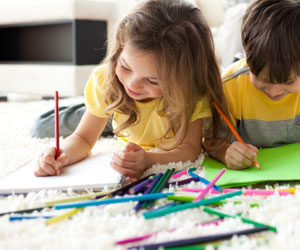Children’s Drawings May Indicate Later Intelligence
How 4-year-old children draw pictures of a child is an indicator of intelligence at age 14, according to research published in Psychological Science, a journal of the Association for Psychological Science.
Researchers studied 7,752 pairs of identical and non-identical twins (a total of 15,504 children) from the Twins Early Development Study (TEDS), funded by the Medical Research Council (MRC) in the UK, and found that the link between drawing and later intelligence seemed to be influenced by genes.
 At the age of 4, children were asked by their parents to complete a ‘Draw-a-Child’ test, i.e. draw a picture of a child. Each figure was scored between 0 and 12 depending on the presence and correct quantity of features such as head, eyes, nose, mouth, ears, hair, body, arms etc. For example, a drawing with two legs, two arms, a body and head, but no facial features, would score 4. The children were also given verbal and non-verbal intelligence tests at ages 4 and 14.
At the age of 4, children were asked by their parents to complete a ‘Draw-a-Child’ test, i.e. draw a picture of a child. Each figure was scored between 0 and 12 depending on the presence and correct quantity of features such as head, eyes, nose, mouth, ears, hair, body, arms etc. For example, a drawing with two legs, two arms, a body and head, but no facial features, would score 4. The children were also given verbal and non-verbal intelligence tests at ages 4 and 14.
The researchers found that higher scores on the Draw-a-Child test were moderately associated with higher scores of intelligence at ages 4 and 14. The correlation between drawing and intelligence was moderate at ages 4 (0.33) and 14 (0.20).
“The Draw-a-Child test was devised in the 1920s to assess children’s intelligence, so the fact that the test correlated with intelligence at age 4 was expected,” says lead researcher Rosalind Arden of the MRC Social, Genetic and Developmental Psychiatry (SGDP) Centre at the Institute of Psychiatry at King’s College London. “What surprised us was that it correlated with intelligence a decade later.”
“The correlation is moderate, so our findings are interesting, but it does not mean that parents should worry if their child draws badly,” explains Arden. “Drawing ability does not determine intelligence, there are countless factors, both genetic and environmental, which affect intelligence in later life.”
The researchers also measured the heritability of figure drawing. Identical twins share all their genes, whereas non-identical twins only share about 50 percent, but each pair will have a similar upbringing, family environment and access to the same materials.
Overall, at age 4, drawings from identical twins pairs were more similar to one another than drawings from non-identical twin pairs. Therefore, the researchers concluded that differences in children’s drawings have an important genetic link. They also found that drawing at age 4 and intelligence at age 14 had a strong genetic link.
“This does not mean that there is a drawing gene — a child’s ability to draw stems from many other abilities, such as observing, holding a pencil etc. We are a long way off understanding how genes influence all these different types of behavior,” says Arden.
“Drawing is an ancient behavior, dating back beyond 15,000 years ago. Through drawing, we are attempting to show someone else what’s in our mind. This capacity to reproduce figures is a uniquely human ability and a sign of cognitive ability, in a similar way to writing, which transformed the human species’ ability to store information, and build a civilization,” Arden adds.





APS regularly opens certain online articles for discussion on our website. Effective February 2021, you must be a logged-in APS member to post comments. By posting a comment, you agree to our Community Guidelines and the display of your profile information, including your name and affiliation. Any opinions, findings, conclusions, or recommendations present in article comments are those of the writers and do not necessarily reflect the views of APS or the article’s author. For more information, please see our Community Guidelines.
Please login with your APS account to comment.